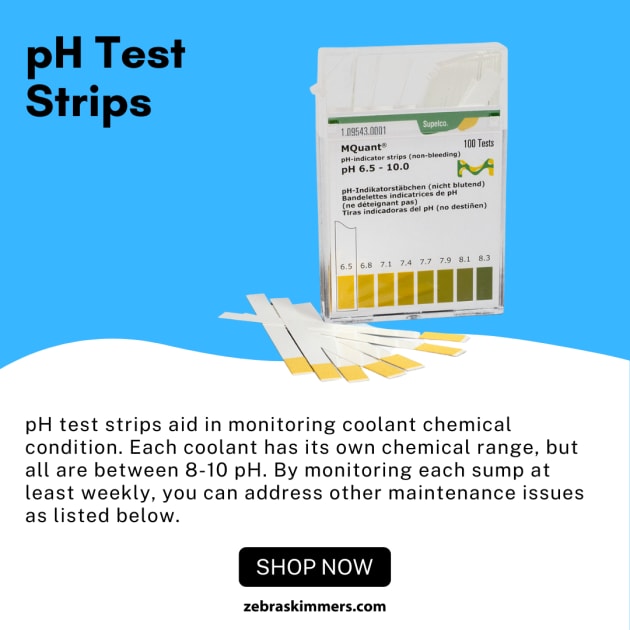Coolant plays a crucial role in maintaining the efficiency and longevity of industrial machinery. But just like any system, your coolant requires consistent monitoring and maintenance to function at its best. One of the most important aspects of coolant care is managing the pH levels. In this guide, we will explore the importance of coolant testing, how to monitor pH levels, and tips for proper maintenance.
What is Coolant and Why Does It Matter?
Coolant, often referred to as coolant fluid or cutting fluid, is essential for temperature regulation in industrial machines. It circulates through the machine, absorbing heat and preventing overheating. But coolant is not just about cooling — it also helps reduce friction, prevent corrosion, and flush away debris and particles.
However, over time, the properties of the coolant can degrade due to environmental factors, contamination, and wear. Keeping coolant in optimal condition is vital for maintaining machine performance and extending the life of both the coolant and the equipment.
The Role of pH in Coolant Health
pH is a measure of the acidity or alkalinity of a solution. In the context of coolant, maintaining the right pH level is vital to preventing corrosion and ensuring the coolant's effectiveness. If the pH is too low (acidic), it can cause the coolant to break down and corrode metal parts in the machinery. If it’s too high (alkaline), it can lead to the formation of deposits, reduced cooling efficiency, and even contamination.
A balanced pH is key to ensuring the coolant can perform its functions without causing long-term damage to your equipment.
How to Test Coolant pH Levels
Testing the pH levels of your coolant is simple and should be done regularly. Here’s how you can test your coolant’s pH:
-
Choose a Testing Method: There are several ways to test coolant pH. The most common methods are using pH test strips or a digital pH meter.
-
Perform the Test:
- If you are using pH strips, dip the strip into the coolant and compare the color change to the provided chart to determine the pH level.
- If using a pH meter, insert the probe into the coolant and read the pH directly on the display.
-
Interpret the Results:
- Ideal coolant pH typically ranges between 7.0 and 9.0, with slight variations depending on the specific coolant type. Anything outside this range indicates an issue with your coolant’s health.
-
Record the Results: It’s always a good idea to log your test results to track any trends over time, which can help detect problems before they become severe.
Why Regular Coolant Testing is Essential
Routine testing of your coolant pH is essential to avoid major machine failures, maximize efficiency, and prevent unnecessary maintenance costs. Here’s why you should test your coolant regularly:
- Early Detection of Problems: Regular testing can identify pH imbalances, contamination, or degradation before they affect your equipment.
- Cost Savings: By maintaining proper coolant chemistry, you avoid the need for expensive repairs or replacements caused by corrosion or overheating.
- Enhanced Performance: Properly balanced coolant keeps your machinery running at optimal temperatures, improving overall performance.
Testing your coolant every 1-3 months is recommended, depending on the usage and type of machinery.
How to Adjust and Maintain pH Levels
If your coolant pH is outside the ideal range, adjusting it is critical. Here are some tips to restore balance:
-
For Low pH (Acidic Coolant):
- Use pH-raising chemicals (such as sodium bicarbonate) to neutralize the acidity.
- Dilute the coolant with fresh fluid to reduce acidity.
-
For High pH (Alkaline Coolant):
- Use pH-lowering chemicals (like phosphoric acid) to bring the pH level down.
- Add small amounts of water if necessary to dilute the coolant and adjust pH.
Tip: Always add chemicals slowly and test the pH after each adjustment to avoid overshooting your target range.
Troubleshooting Coolant Problems
If you notice signs of poor coolant health, such as excessive foaming, foul odors, or visible corrosion, it could be time for an in-depth evaluation. You may have hard water that causes the foaming so testing with Water Hardness Test Strips can help you figure that out. Here are a few common causes of pH imbalances and potential solutions:
- Contamination: Dust, debris, or foreign fluids can alter coolant chemistry. Regular filtration and cleanliness will reduce contamination risks.
- Excessive Heat: Running machinery at high temperatures for prolonged periods can cause coolant breakdown. Also, if your shop is not temperature controlled and the overall air is hot, your coolant can be affected. Ensure your cooling systems are functioning correctly.
- Improper Mixing: Using the wrong water-to-coolant ratio can lead to pH imbalances. Always follow the manufacturer’s instructions on dilution.
Tools and Resources for Effective Coolant Management
There are several tools and resources that can help streamline coolant maintenance:
- pH Meters: For precise readings of your coolant’s pH.
- Refractometers: Used to measure coolant concentration, ensuring proper mixture levels.
- Coolant Filtration Systems: Automated systems to keep coolant free from debris and maintain its quality.
- Coolant Additives: Chemical solutions that help regulate pH and prevent contamination.
Automating coolant testing like with the Dazzle 2 Coolant Automation System with sensors that alert you when the pH is out of range is a great investment for companies looking for more consistent monitoring.
Maintaining balanced coolant pH is critical for machine performance, longevity, and cost-efficiency. Regular testing, adjustments, and proper maintenance practices ensure your machinery remains in top working condition and minimize costly downtime. Start implementing a solid coolant management strategy today, and you’ll be investing in the future of your equipment.
Delving Deeper: pH Water Test Strips
One of the most important parameters that coolant test strips measure is pH. The pH value of a coolant indicates its acidity or alkalinity. An imbalanced pH can lead to a host of issues like corrosion, excessive foaming, and biological contamination.
This is where pH water test strips come in. Using these strips is as simple as dipping them in the coolant and observing the color change. The changed color can be matched with the pH test strip color chart to get an accurate measure of the pH level.
Overall, effective coolant maintenance is a critical factor in ensuring smooth and efficient machining operations. Regular use of coolant test strips and also pH water hardness strips can simplify the process. This provides an accurate, convenient, and cost-effective way of monitoring coolant health. Understanding along with interpreting the pH test strip color chart and coolant pH level chart are essential skills in maintaining optimal coolant conditions.
Whether you’re a seasoned professional or a beginner in the machining world, remember, proactive testing is key to preventing issues and ensuring the longevity of your machinery. So, keep those test strips handy, and let’s promote effective coolant maintenance for better machining performance!
 |
 |
***
About Zebra Skimmers:
Our mission has always been simple. It is to provide the metal working industry with the oil skimmers and metalworking fluid management systems they need to complete jobs quickly and efficiently. Innovative and affordable solutions have gained us many accolades. Our continued growth is due in no small part to our excellent customer service… Not to mention our satisfaction guarantees and the performance of our tools.
Among our diverse options of oil skimmers and metal working fluid management systems, you can expect to find:
- Coolant management equipment, which includes coolant mixers, proportioning pumps, and also coolant automation systems to mix and deliver fluid solutions at the desired concentrations.
- Industrial oil skimmers, including tramp oil belt skimmers, disk skimmers, tube oil skimmers, and individual sump coalescers as well for the removal of surface and tramp oils from fluids.
- Aeration or circulation equipment and sump odor control tablets to control fluid odor and overall machine shop smell
- Industrial fluid monitoring equipment, including brix refractometers to verify fluid solution concentrations, pH test strips and also water hardness testing sticks.

